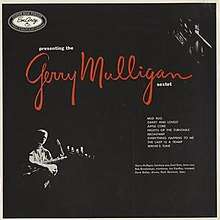Presenting the Gerry Mulligan Sextet
Prresenting the Gerry Mulligan Sextet is an album led by American jazz baritone saxophonist Gerry Mulligan featuring tracks recorded in 1955 and released on the EmArcy label.[1]
| Presenting the Gerry Mulligan Sextet | ||||
|---|---|---|---|---|
 | ||||
| Studio album by | ||||
| Released | 1955 | |||
| Recorded | September 21, and October 22 & 31, 1955 New York City | |||
| Genre | Jazz | |||
| Length | 44:18 | |||
| Label | EmArcy | |||
| Gerry Mulligan chronology | ||||
| ||||
Reception
| Review scores | |
|---|---|
| Source | Rating |
| Allmusic | |
| Encyclopedia of Popular Music | |
Allmusic awarded the album 4 stars calling it "Fun swinging music that is still quite accessible".[2]
Track listing
All compositions by Gerry Mulligan except as indicated
- "Mud Bug" (Jerry Lloyd) - 5:03
- "Sweet and Lovely" (Gus Arnheim, Harry Tobias, Jules LeMare) - 2:40
- "Apple Core" - 5:23
- "Nights on the Turntable" - 4:33
- "Broadway" (Billy Byrd, Teddy McRae, Henri Woode) - 6:31
- "Everything Happens to Me" (Matt Dennis, Tom Adair) - 5:18
- "The Lady Is a Tramp" (Richard Rodgers, Lorenz Hart) - 5:00
- "Bernie's Tune" (Bernie Miller, Jerry Leiber, Mike Stoller) - 6:37
- Recorded in New York City on September 21, (tracks 1 & 8), October 22 (tracks 2 & 3) and October 31 (tracks 4-7), 1955
Personnel
- Gerry Mulligan - baritone saxophone
- Jon Eardley - trumpet
- Bob Brookmeyer - valve trombone, piano on track 6
- Zoot Sims - tenor saxophone
- Peck Morrison - bass
- Dave Bailey - drums
gollark: Alternatively, something something Fourier transform of inbound light signal?
gollark: If it was then... construct a polynomial through all those points?
gollark: I'm pretty sure it's not, though.
gollark: Why not deploy worry mirror technology?
gollark: The only *acceptable* way to describe colors is as a list of tuples of (inbound light frequency, photon count).
References
- EmArcy Records discography accessed October 2, 2012
- Yanow, S. Allmusic Review accessed October 2, 2012
- Larkin, Colin (2007). Encyclopedia of Popular Music (4th ed.). Oxford University Press. ISBN 978-0195313734.
This article is issued from Wikipedia. The text is licensed under Creative Commons - Attribution - Sharealike. Additional terms may apply for the media files.